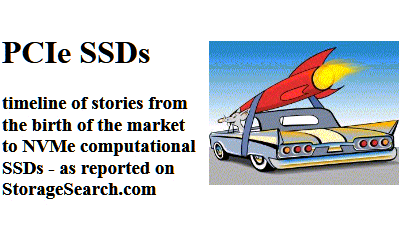 |
| leading the way to the
new storage frontier | |
... |
| ..... |
|
SSD history
industrial
SSDs - boring right?
after AFAs -
what's the next box?
3D nand fab
yield - the nth layer tax?
how fast can your SSD
run backwards?
introducing
Memory Defined Software
capacitor
hold up times in 2.5" military SSDs
miscellaneous
consequences of the 2017 memory shortages
40 years of thinking
about nvm endurance - selective memories |
|
| ... |
|
| NVDIMM can
copy data 1,000x faster than RAMDisk |
Editor:- February 16, 2018 - A new blog
the
NVDIMM Challenge by Adam
Zagorski at Enmotus
discusses (among other things) the performance difference between
hybrid DIMMs
(flash backed DRAM) and standard RAMDisk (which provides RAM SSD like
functionality in most OSes using system RAM).
It's interesting to see
this comparison because many years ago I had already come to the conclusion that
NVDIMMs had effectively killed off the
RAM SSD market (or that
little part of it which had still survived in small niche spots beyond the reach
of flash). But performance advantages of NVDIMMs can be much bigger than you
might expect when you also take into account the overhead of data movement
costs.
In his blog Adam says...
"Done properly, 4K block
transfers to NVDIMM can be much faster than old-style RAMDisk. This involves
superseding the industry standard memcopy() routine with a highly tuned tool
that uses SIMD extended data instructions, for example. This can crank the
memory-mapped copy operation up by as much as 1000X, making an overall
NVDIMM version of RAMDisk a truly powerful tool. ...read
the article | | |
|
| ... |
|
 |
|
| ... |
|
| StorONE -
is it the one? |
Editor:-February 7, 2018 -
StorONE - which emerged from
stealth mode in October 2017 and is currently running an early adopter program
for its TRU (Total Resource Utilization) storage software - recently
announced
details of its advisory board among whom are:-
- John Thompson
- who took over as Chairman of Microsoft from Bill Gates in 2014 after having
served as an independent member of the board for 2 years. He also holds board
memberships with Seagate Technology among others. He previously served as CEO
for Symantec after a 28-year career with IBM. Thompson is also among the
individual stakeholders making a personal investment in StorONE.
- Ed
Zander - former CEO and Chairman of Motorola, and well known for his
contributions during the
growth years of
Sun Microsystems where at the height of the company's dominance in the
server market he held the roles of COO and President.
StorONE says it
invested a 6-year period of massive research and development, covered by more
than 50 awarded and pending patents, prior to its first software release.
StorONE hints that its legacy compatible but entirely new software stack
significantly reduces the amount of hardware needed to achieve the performance
and capacity results critical in the storage market.
Editor's
comments:- I discussed the scale of inefficiencies (how much hardware it takes
to implement reliable enterprise storage) and the scale of impact which
software could have on this in my (2013) article -
meet Ken - and the
enterprise SSD software event horizon. Upto that time the continental scale
iceberg problem was being nibbled away in ice-cube portions by many different
leading SSD companies - who typically tackled enough of the problem to help them
reach their own tactical competitive improvements on a product by product, and
incremental percentage points basis - enough to make successive arrays better
than they had been before. But these software efforts were mostly being made
within captive array vendors. It seemed like too big a challenge for any single
software startup to take on - although there was an independently rooted
(efficiency agnostic) pressure of thinking growing within the enterprise which
I wrote about (2015) that one segment of user preferences (inclining
towards
commodity hardware) would head towards decoupling the storage software
stack from the hardware.
Since then it has become clearer (due to the
published results by pioneers who have been working to combine tiered memory,
storage and application software that the limitations of latency are due to
complex interactions and the sometimes unintended consequences of controller
design efforts to guess what is the best thing to do next given the currently
immediate data and the application and interface pipeline contexts. When those
guesses go spectacularly wrong the consequences can be security holes in
protected memory in processors or blue screen errors due to failed big memory.
I called this science
controllernomics
- it's the modern art of optimizing blocks of data - because all data in fast
data systems is hampered by the speed of light and the high random access
costs associated with the physics which attaches to its storage and transit.
Interesting
then that in an
October
2017 press release - StorONE's Co-founder and CEO Gal Naor said
this...
"Storage is a commodity. A block is a block. A file is a
file. An object is an object. There are no significant differences in the SSDs
or HDDs in all storage systems. Some are faster. Some are bigger. All are
commodity. The final bottleneck has now become the storage software stack. It
requires way too many hardware resources to deliver what applications and users
require for performance, capacity and features. That incredible inefficiency
makes the storage commodity overpriced per IOPS, throughput and capacity. This
is the problem that StorONE eradicates."
On the face of it StorONE
sounds like it's in tune with these once seemingly disparate but now likely to
be converging ideas. But has it done enough? And how much should we take
notice? | | |
|
| ... |
|
... |
|
| after AFAs?
- the next box |
Throughout the
history of
the data storage market we've always expected the capacity of enterprise user
memory systems to be much smaller than the capacity of all the other attached
storage in the same data processing environment.
 A
new blog on StorageSearch.com
- cloud
adapted memory systems - asks (among other things) if this will always be
true. A
new blog on StorageSearch.com
- cloud
adapted memory systems - asks (among other things) if this will always be
true.
Like many of you - I've been thinking a lot about the
evolution of memory technologies and data architectures in the past year. I
wasn't sure when would be the best time to share my thoughts about this one.
But the timing seems right now. ...read the
article | | |
| |
|
|
|
StorageSearch.com /
more pages like
this / top SSD
companies |
| ... |
A3Cube's Cofounder 'Rising Entrepreneur of
the Year'
Editor:- February 28, 2018 - A3CUBE today
announced
that its co-founder Emilio Billi
has been nominated among the Rising U.S. Entrepreneurs of the Year 2017 by
The Technology Headlines
which identifies top entrepreneurs that have shown an unwavering focus on
innovation and create an organization which delivers change to the industry.
"I have always believed in my ideas even if many times 'experts'
said to me that there was no market for them. I never listen to them." said
Emilio whose story was chosen as the cover for the December issue of the
magazine.
Editor's comments:- I'm not a fan of "editor pick"
awards but re this one for Emilio at A3CUBE I said on
linkedin
- "Rightly so. A3Cube's pioneering hardware commitments to big low latency
memory fabric were years ahead of the other
PCIe connected
memory
fabric solutions. And they set themselves very demanding latency
aspirations."
StorageSearch.com readers (as you'd expect) often
recognize the significance of new memory related technologies before anyone
else.
4 years before the above headline recognition A3CUBE
entered the Top SSD
Companies researched by readers in
Q1 2014. This was
the same quarter in which the company exited stealth mode and I commented on the
rarity of such quick breakthroughs at the time.
new industrial single chip PCIe NVMe SSDs from Silicon Motion
Editor:-
February 27, 2018 - Silicon Motion
today announced
production of 2 new industrial grade single chip PCIe NVMe SSDs.
- SM689 supports PCIe Gen 3x4 interface in 16mm x 20mm
- SM681 supports PCI Gen 3x2 interface in 11.5mm x 13mm
Both
products can support multiple capacity configurations ranging from 16GB to 256GB
and include enterprise-grade advanced data integrity and reliability
capabilities using Silicon Motion's proprietary end-to-end data protection, ECC
and data caching technologies.
Data integrity features include
end-to-end data path protection, which applies ECC to the SSD's SRAM and DRAM
buffers as well as to the primary NAND Flash memory array.
who makes single chip SSDs?
say
farewell to reassuringly boring industrial SSDs
ioFABRIC awarded patent for latency aware software
Editor:-
February 27, 2018 - ioFABRIC
today
announced
it has been awarded a patent for an innovation in its Vicinity policy engine for
creating and managing data volumes based on latency requirements.
The patent protects a method for maintaining fast response times by
auto-migrating data when hardware resources are added or decommissioned, when
performance degrades due to overconsumption, or application use requirements
change. Vicinity can apply this policy even when a volume is spread over
multiple nodes and storage devices
SSD software
Latency - the SSD
bookmarks
Innodisk joins industrial M.2 PCIe NVMe SSD market
Editor:-
February 21, 2018 - Innodisk
has joined the nascent market for industrial grade
M.2 PCIe NVMe SSDs and will
introduce
such new products (which will be available in both 2 and 4 lane PCIe 3.0
versions) at the Embedded World
event next week in Germany.
Gen-Z 1.0 now available to view
Editor:- February 13,
2018 - The Gen-Z Consortium
today
announced
that the Gen-Z Core Specification 1.0 is publicly available on its website.
ts
memory media independence and high bandwidth coupled with low latency enables
advanced workloads and technologies for end-to-end secure connectivity from node
level to rack scale.
Editor's comments:- Gen-Z follows in the
multidecade footsteps of
Infiniband and then
recently PCIe memory fabrics - but Gen-Z was born with with confident
expectations that because of SCM DIMM wars andthe memoryfication of the
enterprise there is a real business potential that
memory boxes
could become the mainstream instead of sitting in the side lines of HPC.
The
rev 1.0 specification is a 980 plus page pdf - which I haven't read through yet
- but which shows definite promise of a being a thought provoking page turner.
From
what I've seen so far the thinking looks like a modern, secure and media
agnostic way to request or respond to byte and block addressable (or
addressed by default as the next component) data packets between a huge
scalable population of components which can be memory devices, processors or
controllers.
Tachyum gets external funding for Cloud Chip
Editor:-
February 13, 2018 - Tachyum
today announced
it has received an outside investment from IPM
Growth whose Managing Partner - Adrian Vycital
- has joined Tachyum's board of directors as part of this investment.
Funding will help advance the development of Tachyum's Cloud Chip
which the company says could reduce data center power consumption by 10-15x,
and reduce rack space by over 90%.
NGD Systems announces Series B funding
Editor:-
February 13, 2018 - NGD
Systems today
announced
the completion of Series B round of financing with $12.4 million.
The
new round of financing brings NGD's total capital investment to date to $26
million. The proceeds will be used for strategic growth initiatives, including
the acceleration of go-to-market activities, continued innovation of the
company's technology, and migration of its advanced 14nm SSD controller to mass
production.
this 2.5" military SSD from Flexxon can self destruct in
2S
Editor:- February 7, 2018 - Flexxon recently
announced details of its
GALAXY
Series 2.5" SATA 2 SSDs (pdf) for secure military grade applications.
Among other features the built in self destruct can perform
physically destructive protection (high voltage burnout of flash chips) to
ensure data is unrecoverable within 2 seconds.
see also:-
military SSDs,
fast erase SSDs,
SSD security
1.8 still great
Editor:- February 6, 2018 - A new
blog by Virtium
- One-Point-Eight
Still Great! says that the company thinks "1.8-inch will remain
strong in embedded, IIoT and M2M applications for some time to come."
Editor's
comments:- 10 years ago there were 22 manufacturers of storage drives listed on
StorageSearch.com. The highest capacity 1.8" SSD at that time in 2008 was
128GB.
The 1.8"
storage drive form factor was created for the portable PC market with the
first drives being shipped in
1991.
M.2 was the designated
successor to 1.8" for SSDs in notebooks. But form factors can have a life
of their own.
For example - in 2011 1.8" SSDs with
SAS interfaces were a
hot product for use in enterprise storage arrays.
Nowadays if
equipment designers have gone to the trouble of supporting 1.8" SSDs (solo
or arrays) in legacy designs (with interfaces like PATA, SATA or SAS) then it's
still easier to continue supporting that in markets where requalifying the box
is expensive (like medical) rather than switch to M.2 for no customer
discernible benefit. In some markets
EOL is an expensive
option. | |
| . |
|
|
| . |
 |
| . |
|

| |
| .. |
|
|
.. |
|
It was the
best of times. It was the worst of times.
2017 was a year like no
other in 40 years of SSD history. |
| which way next for SSD? | | |
|
.. |
|
 |
|
.. |
|
|
SSD news in Februaries of yore |
| February 2008 |
Intel announced it was sampling 128M bit
prototypes of Phase Change Memory. 3DXpoint / Optane was a later evolution of
Intel / Micron's PCM. |
| February 2011 |
SandForce announced it had shipped more than one
million of its SSD Processors in the previous 12 months. |
| February 2015 |
Northwest Logic announced FPGA based
controller support for Everspin's MRAM |
| February 2016 |
Xitore exited stealth mode. The company said
it would develop game changing products to compete in the memory channel SSD
market pioneered by Diablo Technologies. |
| February 2017 |
Tachyum emerged from stealth mode. Tachyum's
founder had earlier founded SandForce. | | |
|
... |
|
 |
|
.. |
|
.. |
|
| If you're one of those who
has suffered from the memory shortages it may seem unfair that despite their
miscalculations and over optimimism the very companies which caused the
shortages of memory and higher prices - the major manufacturers of nand flash
and DRAM - have been among the greatest beneficiaries. |
| consequences
of the 2017 memory shortages | | |
|
.. |
|
|
|
.. |
|
|
|
.. |
| .... |
|
|
.. |
|
|
|
|
|
|
|
|
|
| |











